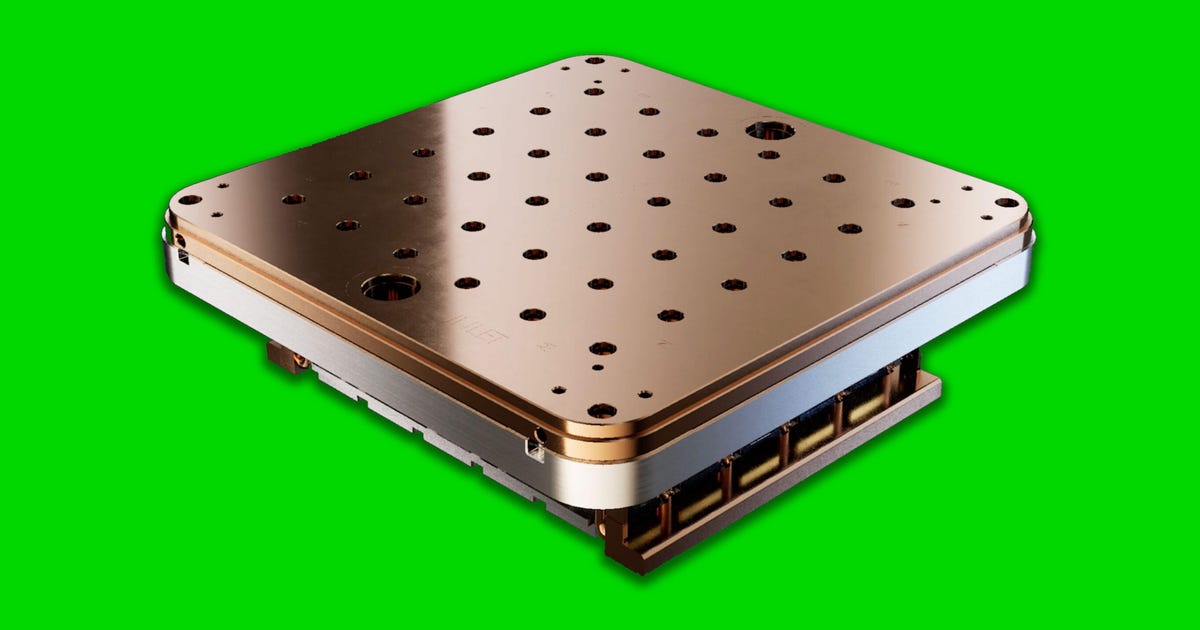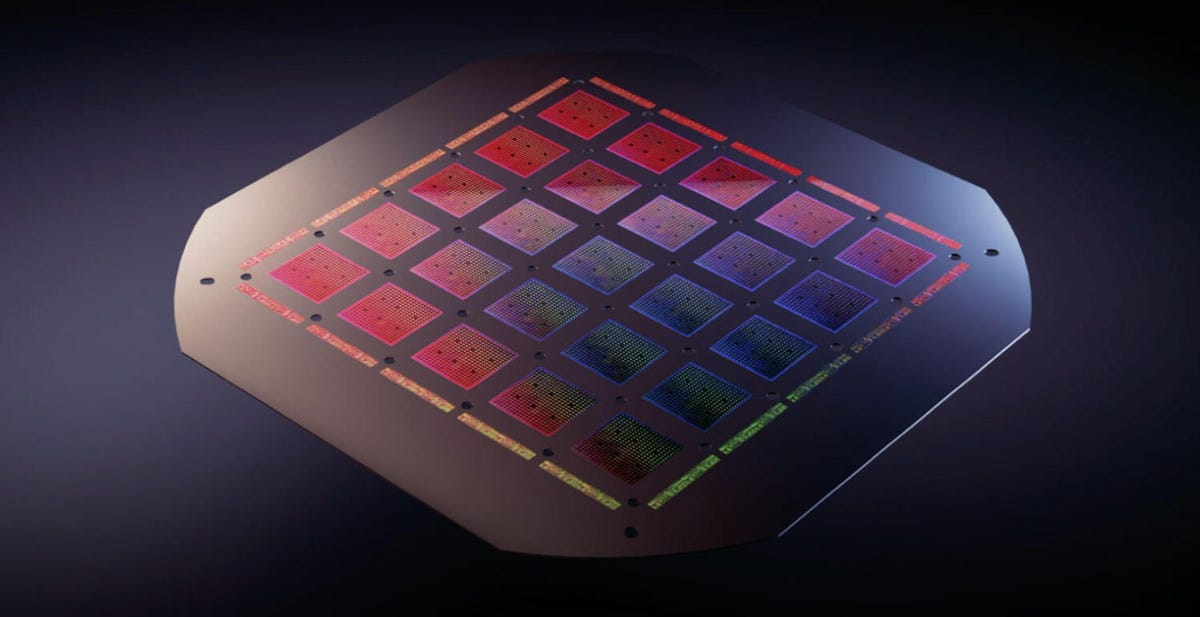
Why Tesla Thinks It’ll Interpretation Self-Driving Cars Before Everyone Else
Tesla has revealed the AI technology it’s achieved to teach its thousands of cars to drive themselves in the race to revolutionize the transportation industry.
The artificial intelligence controls, called Dojo and detailed Tuesday at the Hot Chips conference, yokes together hundreds of its D1 chips into hulking “exapods.” Their job is to treat video from the fleet of Tesla cars on the road immediately to learn how real-world driving works. That training treat is the foundation for the FSD, short for Full Self Driving, that Tesla expects will eventually pilot its cars above freeway interchanges, parking lots and traffic signals.
Tesla has struggled to protest that FSD product to customers, many of whom paid for it days ago, because training an AI to deal with the complexity of the real humankind turned out to be much more computationally challenging than Tesla required. Dojo’s massive computing horsepower is designed to finally make self-driving Teslas a reality.
FSD immediately is in limited beta testing and requires constant humankind oversight that disqualifies Teslas as truly self driving. Except, Tesla Chief Executive Elon Musk expects the technology to pave the way to fully autonomous vehicles — a significantly harder challenge that intends cars to be able to pilot themselves with no humankind driver at all.
Tesla first started talking throughout Dojo in 2021 at its AI Day event. At Hot Chips, Tesla detailed how Dojo’s D1 chips work and how they’re linked together by the dozens or hundreds into a tremendous computing fabric.
“We need to accelerate these AI accelerators,” Ganesh Venkataramanan, who leads Tesla’s autonomous vehicle hardware effort, said in a Hot Chips talk.
The AI training hardware is flexible enough to accommodate a wide way of AI models, not just the video processing that Tesla produces for driver assistance and autonomous vehicles. That’s important given the way of Tesla’s ambitions, which also include projects like its Optimus personal robot. The Optimus would need skills in navigating an entirely different environment.
A look inside Tesla’s Dojo
To enact that speedup, the electric vehicle maker starts by designing its D1 chips for its own be affected by, chiefly processing video data that tracks a car’s altering environment. Handling that four-dimensional space — three spatial dimensions and one for time — is much harder than looking at a single frame of video.
D1 chips are then linked in groups of 25 into a single square “training tile” near as wide as a dinner plate. Training tiles are linked edge to edge with neighbors into a grid. Data attempts from tile to tile like cars driving city blocks or for longer journeys, using a network that’s more like a regional slow train.

The foundational processor in Tesla’s Dojo AI making system is the D1 processor, 25 of which are grouped in a vast package called a training tile.
Tesla
There are plenty of manufacturing standards to help build this kind of thing, but Tesla customizes everything from the orderliness set that commands the D1 chips to the network technology and the AI software framework that runs the show.
Tesla said it plans to move AI making from Nvidia processors to Dojo to speed up the work, but It’s yet not certain how far through the transition Tesla is. “We’ve had hardware for a once, and we are running it in the lab,” hardware engineer Emil Talpes said in a Hot Chips talk.
Tesla plans to portion details on Dojo’s speed at its AI Day maintain on Sept. 30. And eventually researchers could get a chance to try out Dojo for themselves. “Elon has made it public that over time we will make this available to researchers, but we don’t have a time frame,” Venkataramanan said.
Tesla’s vertical integration
Traditional automakers rely on a vast network of component suppliers for everything from seats to infotainment rules, but Dojo shows how Tesla prefers to build the technology itself. That approach, called vertical integration, extends through manufacturing, software, sales, service and even to the Supercharger network where Tesla owners can poster their cars.
Vertical integration is on the upswing in the tech manufacturing. It gives companies tighter control over their products and services so they all work together smoothly for customers. And it means companies don’t have to share profits with suppliers and novel business partners.
Vertical integration has benefited Apple, which designs its own iPhone and Mac chips, writes the core software for its products, and cmoneys services like iMessage and Apple TV Plus that those devices tap into.
Tesla’s regulation lets it ship software updates relatively easily and poster $10 a month for online services like music streaming and live traffic updates.
But as ages of work by companies like Tesla, Alphabet’s Waymo and General Motors’ Cruise shows, building autonomous vehicles is profoundly hard. Even Tesla’s technically acumen hasn’t cracked the
Promises, promises
Tesla has been selling FSD for ages without delivering. In 2016, it said all its new Teslas had the indispensable hardware, though in 2019 it began upgrading cars with computing hardware based on Tesla’s own AI chips. Now Tesla hopes to expand its testing to a broader set of beta testers by the end of 2022. Don’t seek information from a firm timeline on when it might arrive for a broader audience.
The novel FSD beta, 10.69, shows progress, early testers report. Musk said the FSD ticket will increase to $15,000 from $12,000 when Tesla releases it to a broader business of testers, the latest of several price hikes.
“Generalized self-driving is a hard dilemma, as it requires solving a large part of real-world AI,” Musk tweeted in 2021. “Didn’t seek information from it to be so hard, but the difficulty is sure in retrospect.”
Why Tesla Thinks It'll Build Self-Driving Cars Before Everyone Else. There are any Why Tesla Thinks It'll Build Self-Driving Cars Before Everyone Else in here.
About Me
Total Pageviews
Search This Blog
Blog Archive
-
-
-
-
-
-
-
-
-
-
- Verizon Fios Internet Review in Santa Clara, Calif...
- Verizon Fios Internet Review in Victorville, Calif...
- Tesla Model Y Is the Most American-Made Car, New S...
- Hidden Text Messages: How to Chat Secretly on an i...
- Samsung Neo QLED TVs promise prettier pictures, be...
- Samsung Leader Jay Y. Lee Granted Presidential Pardon
- Palmetto Solar Review: A Strong Choice for Going S...
- Verizon Fios Internet Review in Denton, Texas
- Verizon Fios Internet Review in Midland, Texas
- Best Cheap Phones for 2022: iPhone, Galaxy, Pixel ...
- Verizon Fios Internet Review in Surprise, Arizona
- Verizon Fios Internet Review in Lafayette, Louisiana
- Verizon Fios Internet Review in Simi Valley, Calif...
- Verizon Fios Internet Review in Kent, Washington
- Verizon Fios Internet Review in Concord, California
- 3-Motor Lucid Air Sapphire Super-Sports EV Debuts ...
- Samsung OLED TV First Look: Why It Will Probably B...
- Samsung's Galaxy Buds 2 Pro Feature Audio Perks, b...
- Verizon Fios Internet Review in Hartford, Connecticut
- Verizon Fios Internet Review in Coral Springs, Flo...
- Verizon Fios Internet Review in Stamford, Connecticut
- Verizon Fios Internet Review in Carrollton, Texas
- Xiaomi overtakes Apple as the world's No. 2 smartp...
- Verizon Fios Internet Review in Roseville, California
- Verizon Fios Internet Review in Gainesville, Florida
- New Electric Car Tax Credits Are About to Radicall...
- Snapchat's first diversity report shows a lack of ...
- Xbox Games Arrive On Samsung TVs in Cloud Gaming Push
- Samsung Galaxy Watch 5: All the Fresh Features, In...
- 'Prey' Review: The Predator Movie You've Been Pray...
- Verizon Fios Internet Review in Thornton, Colorado
- Verizon Fios Internet Review in Elizabeth, New Jersey
- Verizon Fios Internet Review in Cedar Rapids, Iowa
- Verizon Fios Internet Review in Topeka, Kansas
- Verizon Fios Internet Review in Charleston, South ...
- Best Buy launches smartphone for elderly community
- Verizon Fios Internet Review in Visalia, California
- Verizon Fios Internet Review in Waco, Texas
- Verizon Fios Internet Review in Thousand Oaks, Cal...
- Verizon Fios Internet Review in Miramar, Florida
- Porsche Taycan Turbo S Beats Tesla Model S Plaid's...
- 43 Labor Day Tech Deals You Don't Want to Miss
- Foldables Are Still Looking for a Breakout Moment....
- Verizon Fios Internet Review in New Haven, Connect...
- Verizon Fios Internet Review in Olathe, Kansas
- AI Arrives for Serious Photo Editing, Not Just Sma...
- Verizon Fios Internet Review in Sterling Heights, ...
- Verizon Fios Internet Review in Columbia, South Ca...
- Verizon Fios Internet Review in McAllen, Texas
- Verizon Fios Internet Review in West Valley City, ...
- Verizon Fios Internet Review in Warren, Michigan
- Elon Musk Sells $7B in Tesla Stock Amid Twitter Ta...
- 5 tips every Snapchat user should know
- Revamp Your Entertainment Space and Save up to $62...
- Pixel 6A vs. Samsung Galaxy A53 vs. Nothing Phone:...
- OnePlus Nord N20 5G Review: A $300 Value Pick That...
- Verizon Fios Internet Review in Bellevue, Washington
- Verizon Fios Internet Review in Frisco, Texas
- Verizon Fios Internet Review in Hampton, Virginia
- Verizon Fios Internet Review in Killeen, Texas
- Smartphone Accessory Deal: This Two-Pack of USB-C ...
- Verizon Fios Internet Review in Fullerton, California
- Verizon Fios Internet Review in Orange, California
- Elon Musk Says Tesla's FSD Software Is Getting a P...
- Samsung QN90B Review: This QLED TV From the Future...
- Samsung TV Plus Gets a Revamp Across Galaxy Device...
- Verizon Fios Internet Review in Pasadena, California
- Verizon Fios Internet Review in Clarksville, Tenne...
- Verizon Fios Internet Review in Syracuse, New York
- Verizon Fios Internet Review in Savannah, Georgia
- Verizon Fios Internet Review in Mesquite, Texas
- Older people are increasingly likely to own a smar...
- Verizon Fios Internet Review in Dayton, Ohio
- Verizon Fios Internet Review in Paterson, New Jersey
- Verizon Fios Internet Review in Naperville, Illinois
- Verizon Fios Internet Review in Hollywood, Florida
- X Shore 1 Aims to Be the Tesla Model 3 of the Sea
- Twitter lets iOS users share tweets as stickers on...
- Samsung Q60B TV Review: Slim, Stylish and Surprisi...
- Samsung Reveals New Gaming Monitor: Odyssey OLED G...
- Insta360 Link Webcam Review: Terrific but Costly
- Verizon Fios Internet Review in Lakewood, Colorado
- Verizon Fios Internet Review in Torrance, California
- Samsung to bring Galaxy smartphone repair service ...
- Verizon Fios Internet Review in Bridgeport, Connec...
- Verizon Fios Internet Review in Sunnyvale, California
- Verizon Fios Internet Review in Escondido, California
- Verizon Fios Internet Review in Joliet, Illinois
- Verizon Fios Internet Review in McKinney, Texas
- Why Tesla Thinks It'll Build Self-Driving Cars Bef...
- Best Smart TV for 2022: Top Picks in Every Budget ...
- What's New for Samsung's Galaxy Z Flip 4: Cool Scr...
- Verizon Fios Internet Review in Kansas City, Kansas
- Verizon Fios Internet Review in Rockford, Illinois
- Verizon Fios Internet Review in Alexandria, Virginia
- Verizon Fios Internet Review in Cary, North Carolina
- Nothing Shares Photo of Translucent Phone 1 Ahead ...
- Verizon Fios Internet Review in Pomona, California
- Verizon Fios Internet Review in Fort Collins, Colo...
- How to enable Snapchat log-in verification
-
-
